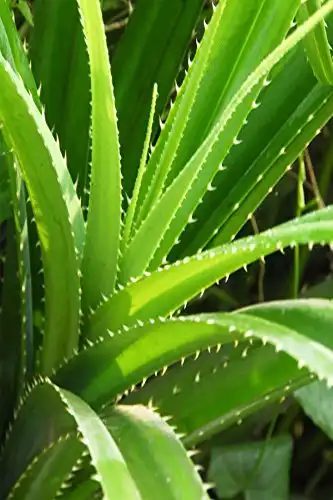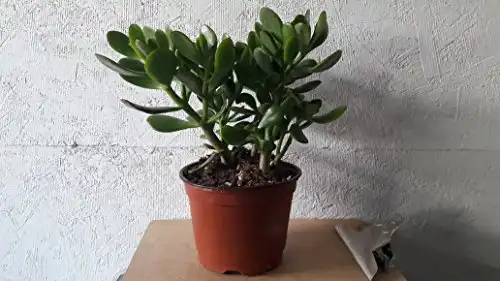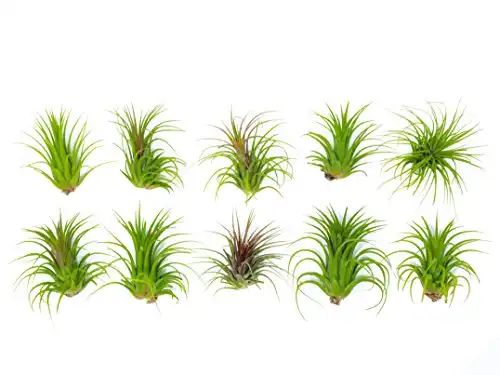Over the years, from my experience and discussing the topic with many gecko owners, I found that 12 plants are commonly used inside a leopard gecko tank.
This is my review of the best plants for leopard geckos. If you are still looking for a plant to decorate your leopard gecko tank, I recommend Crassula ovata as the best overall choice.
However, you need to know that 11 other plants also made it to the list in spite of not being the absolute best.
You might want to consider choosing any on the list if you prefer a plant that suits your tank’s desert motif or if you opt to match your expertise as a gecko and plant owner.
Description: Aloe vera is famous for its consumption and decoration purposes. So, you would not have trouble finding one for your leo in the nearby flower shops. | Description: Crassula ovata is a miniature house plant popular to plant hobbyists as harmless ornaments. As a result, you can add it to your small tanks without taking up too much space. | Description: Tillandsia slows its growth over time. This could be advantageous for you if you have insufficient time to do special caring for the plant. |
Aloe vera is famous for its consumption and decoration purposes. So, you would not have trouble finding one for your leo in the nearby flower shops.
Crassula ovata is a miniature house plant popular to plant hobbyists as harmless ornaments. As a result, you can add it to your small tanks without taking up too much space.
Tillandsia slows its growth over time. This could be advantageous for you if you have insufficient time to do special caring for the plant.
Best Plants for Leopard Geckos: Full List
Here is the list of the plants that can all be used inside a leopard gecko tank:
- Crassula ovata (Best Plant for Leos Overall)
- Aloe vera (Best Popular Plant for Leos)
- Tillandsia spp. (Best Versatile Plant for Leos)
- Epipremnum aureum (Best Resilient Plant for Leos)
- Euphorbia milii (Best Leo Plant for Desert Tank)
- Schlumbergera bridgesii (Best Leo Plant for Tropical Tank)
- Lithops spp. (Best Leo Plant for Small Tank)
- Rhipsalis elliptica (Best Leo Plant for Large Tank)
- Senecio rowleyanus (Best Leo Plant for Tank’s Flooring)
- Sansevieria trifasciata (Best Leo Plant for Tank’s Backdrop)
- Senecio radicans (Best Leo Plant for Newbie Plant Owners)
- Echeveria spp. (Best Leo Plant for Expert Plant Owners)
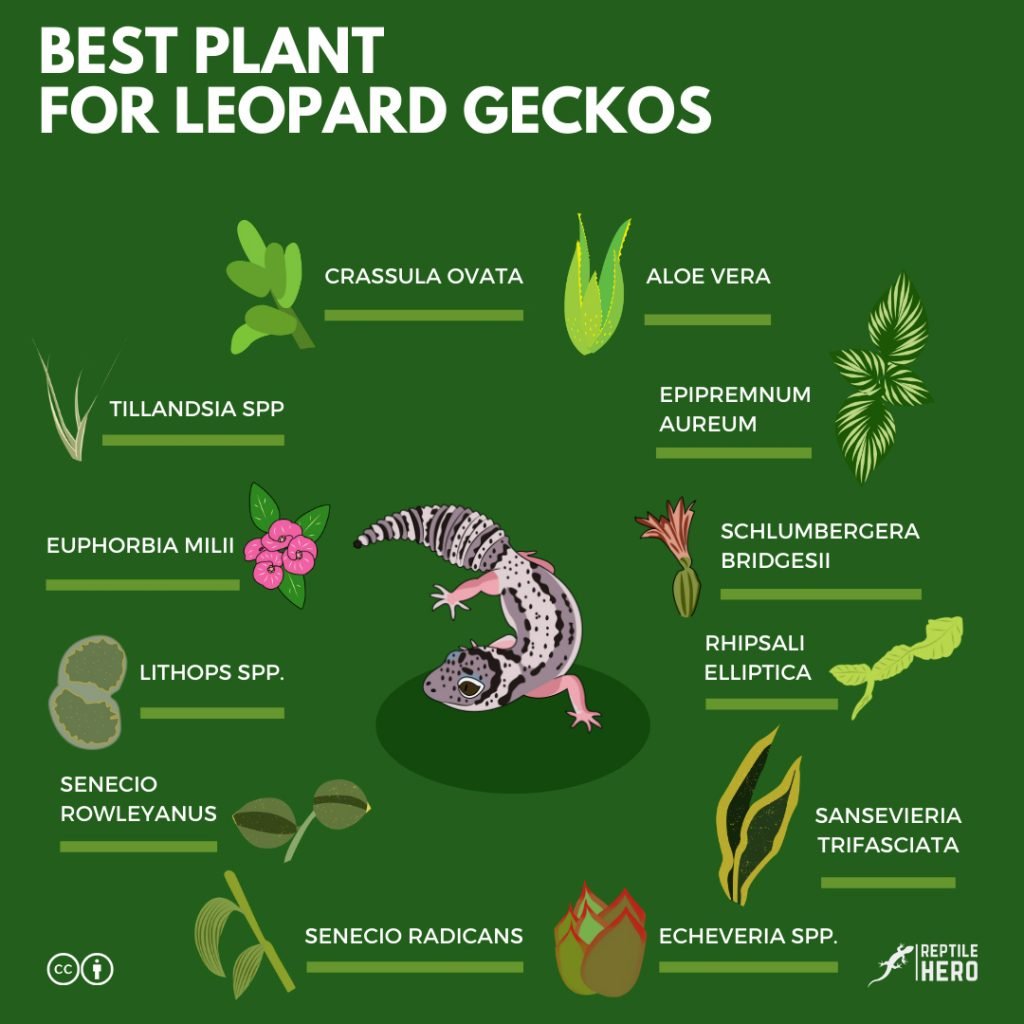
Crassula ovata – Best Plant for Leos Overall
Common Names: Jade Plant or Money Tree
Origin: South Africa and Mozambique
Pros:
Crassula ovata is the plant I believe is the best for leopard geckos.
Also known as the Jade plant, Crassula ovata is a miniature house plant popular to plant hobbyists as harmless ornaments. As a result, you can add it to your small tanks without taking up too much space. Resembling other common bonsai trees, the Jade plant has thick stocky trunks and rounded green leaves. Your gecko would surely enjoy utilizing it as climbing and resting spots atop the plant.
Additionally, it can live for many years. As a matter of fact, I have known several friends who have inherited a Jade plant from their parents. In turn, this was also handed on by their grandparents. Thus, I can assure you that this plant could live as long as your leo.
Ultimately, it is the epitome of hardy plants. What is best about the Jade plant is it likes the arid environment of your gecko’s tank. With minimal water needs and low humidity level requirements, living alongside your leo is not a problem.
Cons:
Although Crassula ovata would not need any special lighting and could tolerate less light, placing it in a tank where no light passes through could make the plant a little spindly.
Setup:
Humidity Level: 30 to 50%
Temperature Tolerance: 30 to 50 °F
Watering Needed: Once in two to three weeks with a light misting once a week.
Light Requirement: Any bright-ish spot.
Aloe vera – Best Popular Plant for Leos
Common Names: Aloe vera
Origin: Arabian Peninsula
I am confident that you know what an Aloe vera is. You may have encountered this wonder plant often or you might even have one already!
Pros:
Aloe vera belongs to the genus Aloe, which encompasses a variety of other species.
There are diverse shapes and sizes you could choose from. Thus, fitting one inside your tank would not be a problem. Though Aloe vera specifically blooms orange-red flowers, some species blossom in diverse colors. If you are up for a tank with a more vivid look, you can opt for pink blush aloe or sunset aloe.
Apart from this, Aloe vera is famous for its consumption and decoration purposes. So, you would not have trouble finding one for your leo in the nearby flower shops.
More importantly, being a sought-after succulent, these hardy plants can thrive well in your gecko’s enclosure. As a result, you can pick the species to decorate your leo’s tank that suits your taste best.
Cons:
Despite tolerating humidity and temperature in the tank, Aloe vera needs six to eight hours of sunlight a day despite it can survive easily with 4 hours of indirect light.
This situation could be challenging if your tank is far from any natural source of intense light, which is not recommended anyway for your gecko. Though this is additional labor for you, what you can do is religiously expose the plant to a place outside the tank where it could sunbathe its needed light.
Setup:
Humidity Level: < 40%
Temperature Tolerance: 10 to 70°F
Watering Needed: Once in three weeks and less during winter.
Light Requirement: A bright spot where it can take the direct sun.
Tillandsia spp. – Very Versatile Plant for Leos
Common Names: Air Plants
Origin: Central and Southern America
Pros:
Tillandsia spp. is a large genus of plants with unique colors and shapes generally known as air plants.
Being an epiphyte, any species of Tillandsia absorbs most of its nutritional requirements directly from the air. Hence, it is the most versatile plant in terms of cultivation. If you have an existing cork bark or driftwood you use in the tank as a hide, you can plant it there or anywhere without worries.
Furthermore, you can hang any from its wide variety on the sides or at the back if you want the jungle look in your gecko’s enclosure. Another point to look into is its slow growth. This could be advantageous for you if you have insufficient time to do special caring for the plant.
On a hind note, I would like to share a tip from my experience. When choosing which species to pick, I recommend you go for the ones with silver foliage. I noticed they tolerate the dry environment better than the others.
Cons:
If you want to keep any Tillandsia species, you must know that all would require a high humid environment harmful to your leo. As a suggestion, you must have time to move the plant out of the tank daily for a light misting or once in three days for a heavy misting.
Setup:
Humidity Level: > 65%
Temperature Tolerance: 20 to 50°F
Watering Needed: Once a week and soak once for two hours in three weeks.
Light Requirement: Brightly lit location out of the sun’s rays.
Epipremnum aureum – Best Resilient Plant for Leos
Common Names: Devil’s Ivy or Golden Pothos
Origin: Mo’orea in the Society Islands of French Polynesia
Epipremnum aureum is a flowering vine you can find in the nearby flower shops and here on Amazon.
Pros:
Some people have commonly known this plant as Golden Pothos because of its green leaves’ yellow streaks. However, most people, including myself, have known this plant as the Devil’s Ivy.
When I first encountered this plant, its name intrigued me until a friend told me the meaning behind Devil’s Ivy. He explained that the plant can live with less supervision in an environment where humidity is low with high temperatures.
Furthermore, some herpers he has talked to has regarded its resilience as almost impossible to kill as a super hardy plant. After experiencing and using it firsthand in my leo’s enclosure for half a year, I could attest to the hardiness of this plant.
Aside from this, I like to occasionally use this plant as a background for my leo’s tank. When you wait and allow it to grow, it has a broad reach that can cover the enclosure’s back.
Cons:
The leaves of Epipremnum aureum are known to contain calcium oxalate, which could be harmful to an herbivorous pet. However, your leopard gecko is carnivorous, specifically insectivorous. Hence, making this plant safe for use in your tank.
Having used this in my enclosure, I have not seen a chance my leo gnawed on the leaves. If you are apprehensive but want to use the plant, you can observe your reptile’s behavior before totally leaving the plant in the tank.
Setup:
Humidity Level: 30 to 70%
Temperature Tolerance: 30 to 60°F
Watering Needed: Once a week with daily misting.
Light Requirement: Bright, indirect light.
Euphorbia milii – Best Leo Plant for Desert Tank
Common Names: Crown of Thorns or Dwarf Apache
Origin: Madagascar
Pros:
Euphorbia milii is a succulent plant that you can find here on Amazon. It has broadleaf evergreen foliage. Since its leaves can grow very big, it is perfect for larger tanks. Thus, I recommend you only pick this plant if you have more space to offer.
You could also enjoy its seasonal flowers in a vivid pink and red color, which could spice up your gecko’s environment. Because this plant enjoys drier conditions, it is ideal if your enclosure has a desert theme along with your other succulents and cacti.
Cons:
Euphorbia milii tend to develop a thorny stem with side branches near the soil line. As a result, it is commonly named Crown of Thorns. If you are not careful, this could cause injury to your gecko. Thus, I suggest you prune this area as needed or cover it with the substrate.
Setup:
Humidity Level: < 30%
Temperature Tolerance: 20 to 50°F
Watering Needed: Once in two weeks and less in winter.
Light Requirement: Three to four hours of direct sunlight each day in a very sunny window.
Schlumbergera bridgesii – Best Leo Plant for Tropical Tank
Common Names: Christmas cactus or Thanksgiving cactus or Easter cactus
Origin: Brazil
Pros:
Schlumbergera bridgesii is a widely known succulent also named Christmas cactus. It is the right choice if your leopard gecko is in a tank with a tropical motif.
Taking care of the Christmas cactus needs a substrate that is not too wet. This allows the succulent to dry over time. Moreover, it requires more space. Thus, it is better to plant it in the background of your large enclosure.
With its common names, you might refrain from adding Christmas cactus to your enclosure. However, it is not like your average cacti that have thorns. As a matter of fact, the Christmas cactus is thornless with long scaly leaves. These leaves cannot hurt your gecko, so there is no need to worry.
Aesthetically, I was fortunate enough to have it blossom. I loved the pink flowers blooming from the plant, which added diversity to my leo’s tank. Other variants may blossom white, red, and orange flowers with rounded leaves. If you have a preference for these colors, you can go for one by checking this link on Amazon.
Cons:
Schlumbergera bridgesii can grow big over time. If your leo’s tank only has adequate space for it to move around, this plant might not be for you.
Besides, it also requires a tank with an excellent drainage system and well-drained soil. If you find this inconvenient, you may opt for other plants on the list.
Setup:
Humidity Level: 50 to 60%
Temperature Tolerance: 20 to 50°F
Watering Needed: Once a week with daily light misting.
Light Requirement: Bright, indirect light is preferred, but low light conditions are tolerated.
Lithops spp. – Best Leo Plant for Small Tank
Common Names: Living Stones or Pebble Plants
Origin: Africa
Pros:
Lithops spp. is a genus of plants with only two thick-padded leaves in all sorts of patterns. This appearance has earned its common name Living Stones. Additionally, this plant could also have flowers in varying colors. This could add assortment to your gecko’s tank.
If you are looking for a functional plant similar to others in this list, you might opt-out of this one. This plant does not provide a hide or a climbing spot for your leo. You cannot even use this as a backdrop. Plainly, it offers itself as a decoration.
However, what is most appealing about this plant is its size. Since it does not grow more than two inches in height, it could easily fit in any tank. Small tanks could even make do with more of this!
In my years of trying out different plants for my leo’s tank, Living Stones are by far one of the weird-looking plants I have ever encountered. If you are the eccentric type, I would highly suggest you try this out by visiting it here on Amazon.
Cons:
Insufficient light in a tank far from the window could cause elongated leaves with poor coloring. If you cannot transfer the tank near a window with sunlight, you might want to skip this plant.
Setup:
Humidity Level: < 40%
Temperature Tolerance: 30 to 40°F
Watering Needed: Once in two to three weeks
Light Requirement: A spot by the brightest window for full sun exposure is preferable.
Rhipsalis elliptica – Best Leo Plant for Large Tank
Common Names: No Common Name
Origin: Brazil
Pros:
Rhipsalis elliptica is a plant with smooth flat leaves with red fruit and yellow flowers. If it is not available in your neighboring flower shops, you can have a look of it here on Amazon.
One of its key features is its preference for well-drained soil, which is easy to do in a large enclosure. Also, its 18-inch form is compact, saving space even if in a big tank.
One unusual thing I found in this plant is it could grow nearly two feet in width though it only grows two inches in length. Even if you have a large enclosure, you may need to, unfortunately, uproot the plant once it outgrows the tank. On the bright side, you can move it to your home garden for repurposing. So, you would not feel bad throwing it away.
Cons:
Rhipsalis elliptica requires an environment with high humidity, which is a big no for leopard geckos. Also, it is prone to root rot if you would not provide special attention.
To manage this plant, what I usually do is to keep the soil moist. However, keep in mind that the roots must not sit in the water for more than half an hour. If you cannot meet its minimal care needs, you might as well check the other plants on the list.
Setup:
Humidity Level: 50 to 70%
Temperature Tolerance: 30 to 50°F
Watering Needed: Once a week.
Light Requirement: Bright indirect morning or evening light. No midday sun.
Senecio rowleyanus – Best Leo Plant for Tank’s Flooring
Common Names: String of Pearls
Origin: Southwestern Africa
Pros:
Senecio rowleyanus is a drought-tolerant succulent plant composed of numerous pearl-shaped leaves. Hence, it is popularly known as String of Pearls in horticulture.
Just like any other succulents, it is easy to look after. It can thrive in a low humid environment with indirect yet bright light, compatible with your gecko’s enclosure.
However, what I find attractive about this plant is its growth speed. With the rate of growth, it makes an excellent flooring for your gecko to step on. In as quickly as more than a week, I warrant you could have a lush ground covering in your leo’s tank. Check it out here on Amazon.
Cons:
Senecio rowleyanus is a vine-growing plant that could grow two feet in length. If you are not intending to use this plant to cover a part or all of the tank’s flooring, you should not add it as your decoration.
Setup:
Humidity Level: < 40%
Temperature Tolerance: 20 to 60°F
Watering Needed: Once in two weeks.
Light Requirement: A spot near the window with intense yet indirect natural light.
Sansevieria trifasciata – Best Leo Plant for Tank’s Backdrop
Common Names: Snake Plant or Mother-in-law’s Tongue
Origin: West Africa
Pros:
Sansevieria trifasciata is a succulent popularly known in the reptile community as the Snake plant. Most herpers I know of have also incorporated this plant once in their herp-life. You can check it here on Amazon.
As this plant can grow pretty long, I suggest you plant it at the back of the tank. With this, you can use it as a great backdrop decoration for your leo’s enclosure once it has grown considerably. To add, the bright green leaves and wide shape of this plant would give you the jungle vibe in your gecko’s tank.
Aside from its visual benefits, you would not have trouble meeting the needed light of this plant. You can easily place it anywhere from light shade to full shade. What is more, its water needs directly correlate with its light requirement. That is, if it is on a darker spot, it would need less water.
Cons:
Sansevieria trifasciata is known to grow pretty long and wide. Hence, it would require more space in your tank. Use it only if you have a reasonably high tank. If you do not have the time to prune and trim the plant, you are better off with other plants on the list.
Setup:
Humidity Level: < 40%
Temperature Tolerance: 10 to 40°F
Watering Needed: Once in two to eight weeks when soil is dry.
Light Requirement: Full sun to light shade.
Senecio radicans – Best Leo Plant for Newbie Plant Owners
Common Names: String of Bananas
Origin: Cape Province in Southern Africa
Pros:
Senecio radicans is a succulent plant (also available in Amazon here).
It has small tendril leaves in its foliage that bear a resemblance to the shape of a banana. Thus, it became popularly known to horticulturists as the String of Bananas.
Though it lives best with well-drained soil in the tank, it considerably tolerates the dry environment in your gecko’s enclosure. Also, you do not need to add specific lighting, unlike others on the list.
What makes this plant even more enticing is its low maintenance and ease of care. Thus, I always suggest this to newbie plant owners commencing their bioactive enclosure journey.
In case you are a forgetful person, you do not need to worry as this plant is forgiving to miss watering schedules. Hence, you could never mess it up even with minimal care unless you deliberately kill it.
Cons:
Since Senecio radicans is also a vine, it can grow up to three feet in length, which could be a hassle for smaller tanks. Thus, I suggest you regularly prune and trim it to keep its growth under control.
Setup:
Humidity Level: 30 to 40%
Temperature Tolerance: 30 to 50°F
Watering Needed: Once in three weeks.
Light Requirement: A spot near a window with very bright, indirect light or morning sun.
Echeveria spp. – Best Leo Plant for Expert Plant Owners
Common Names: Mexican Hen and Chicks
Origin: Central America
Pros:
Echeveria is a genus of flowering plants originating in semi-desert conditions in the wild. Thus, adding this to your gecko’s tank would not be a problem.
Moreover, these flowering plants are popular succulents that gardens and floral arrangements occasionally feature. Hence, finding one in your typical flower shops is what I can guarantee.
Personally, this is one of my favorite plant decorations in my gecko’s tank. Coming in different colors and shapes, I switched out between other species to suit my mood and taste.
If you are an expert plant owner, I highly recommend adding Echeveria in your leo’s enclosure as ease of care could make this a fantastic option for you. You can have a look at what it looks like here on Amazon.
Cons:
Echeveria prefers sunlight and thrives well in such conditions. This could pose a problem for tanks that are away from windows or in dark rooms.
This is a must-have for enclosures getting enough sunlight. Otherwise, I suggest you move the tank near a window for your plant if you like to decorate one in your tank.
Setup:
Humidity Level: < 40%
Temperature Tolerance: 20 to 50°F
Watering Needed: Once in two weeks in summer. Once a month in winter.
Light Requirement: A day’s full sunlight.
Hit me up!
What do you think? Did I miss any plants? Do you have any cool setup that you want us to feature in this article? Let me know!
To sum up, here is the list of my three favorite plants for a leopard gecko tank:
- Crassula ovata (Best Plant for Leos Overall)
- Aloe vera (Best Popular Plant for Leos)
- Tillandsia spp. (Best Versatile Plant for Leos)
6 Factors To Choose a Plant For a Leopard Gecko Vivarium
After skimming through the list above, you must be acquainted by now with how plants do not certainly have needs that coincide with your gecko’s tank and its conditions.
Hence, keeping a live plant for the long term inside your leo’s enclosure entails time and diligence with a little bit of luck.
The best plant for a leopard gecko vivarium needs to be able to at least survive the enclosure’s conditions. Hence, a plant for a leopard gecko’s enclosure needs to satisfy the following conditions:
- minimal water requirement
- no additional lighting
- thrive at the tank’s temperature
- be low maintenance
- be decorative but also useful
- be gecko-safe
6 Factors To Examine
There are countless other plants in the world that I have not included in my list above. Among these plants, I have incorporated them into my tank with success. However, I have yet to try most of those in the future.
Thus, there is a high probability of you coming across plants I do not know you really want to integrate into your bioactive enclosure. As a result, you might want to ask me what features I should search for in plants.
Unless you have the luxury of commitment to provide additional labor to meet your plant’s demands consistently, you must check these six features to make the most out of your chosen plant without piling up stress on you.
Water
Like your leo, a plant is a living being with water needs. When choosing a plant candidate for your tank, you must note that a species with minimal water demands is the must-have in the enclosure.
For instance, Crassula ovata‘s once-every-two to three weeks watering needs is an ideal example to refer to when choosing a plant. With less watering demand and misting needs, you remove excess baggage from your responsibilities in keeping it alive and well.
Aside from that, this factor keeps your tank’s humidity level at bay and within your gecko’s desirable range. After all, your gecko’s welfare is the most important.
Thus, a better choice is always a plant with lesser water needs.
Light
Aside from water, light is another basic need of a plant to photosynthesize and keep it alive. Choosing a plant in terms of its light needs could be troublesome since most of them require more light than what your enclosure has to offer.
To get around this, you should consider only plants that thrive on partial shading. With this, you could bypass buying a separate bulb for the sole purpose of lighting the plant.
Moreover, you evade the need to transfer your tank near a window for natural morning light. This case avoids the risk of overshooting your tank’s temperature just to supply adequate full sunlight for the plant.
That is why with Crassula ovata, you need not worry about any special lighting or additional equipment since it could thrive in any bright-ish spot your tank is located.
Hence, you should always go for a plant that can thrive in your tank’s lighting.
Temperature
Temperature is a common denominator between the plant and your gecko. So, you would instead want to pick a plant where your gecko naturally lives in the wild. For your reference, the United States Department of Agriculture has a guide map you can look into for geographical hardiness [1].
Hardiness refers to a plant’s temperature tolerance. In a gecko’s tank, I recommend choosing plants within zone 9 or above (20°F and above).
With Crassula ovata‘s temperature tolerance above 20°F (30 to 50°F), your leo and its tank do not need to adjust for the plant’s temperature necessity.
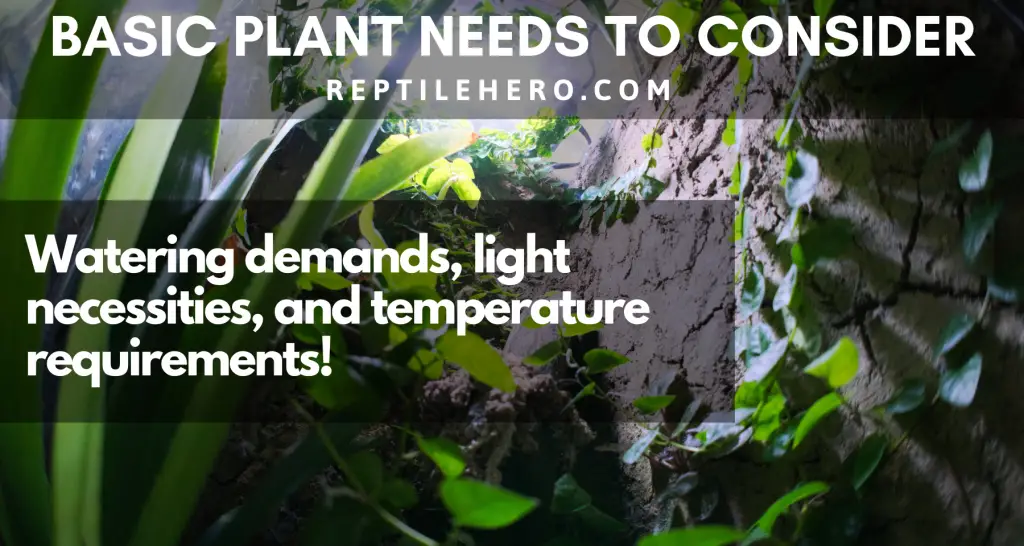
Tough
Aside from it being visually pleasing, the plant you should choose must be rigid too. This statement means it must be firm that your gecko could not easily tread over it.
As a matter of fact, it has to be sturdy enough to support your leo’s climbing behavior which Crassula ovata‘s solid and stubby trunk could offer. Furthermore, a tough plant also means that it should tolerate low care. I do not like to spend and waste my time every day to tend to its needs. I bet you too.
Choosing the right plant for your leopard gecko tank would allow you to provide minimal husbandry without hindering your usual routine.
Functional
Naturally, having live plants in the enclosure could help normalize humidity and improve air quality. Both of which the plant inherently provides to keep your gecko healthy and the environment self-sustaining. Though you could already take into account its appearance for aesthetic functionality, it would be better if the chosen plant has other purposes.
For example, choosing a plant like Crassula ovata which could also act as a climbing accessory is better than a plant just for visual purposes. Its branches and leaves offer a natural feel of the gecko’s habitat in the wild.
Also, a plant that could double as a hide is always better, helping your gecko feel more comfortable and at peace. Seeing your leo rest under it could be rewarding. Aside from this, adding a plant with broader and larger leaves could retain water droplets that your gecko would love to quench for its thirst. This option fairs better compared to plants with narrower and smaller leaves.
When choosing a plant for leopard gecko, it is important to take into consideration its many functionalities.
Safe
Since your gecko is the main star in its enclosure, its safety must be your number one priority above anything else.
Despite being confident that it is entirely carnivorous, I suggest you remain vigilant when introducing new plants in its tank. Its curiosity might drive it to nibble the leaves, so you must have an eye on it in the first few hours.
To steer clear of the hassle, you must be aware of these common plants and seeds that are hazardous to your pet: apple, apricot, peach, pear, and tomato plants [2]. Furthermore, several popular flowering plants also pose a threat to your leo: morning glories, calla lilies, hyacinths, and periwinkle [3].
With Crassula ovata‘s absence from the list, this has proved the anecdotes from other experts and my experience that the plant is safe for use.
In case you also have fake plants alongside real ones, you should keep away from these features and materials: heavily dyed fabric or silk ones made out of porous materials with protruding metal wires and rough edges. Thus, I recommend choosing artificial plants made out of aquarium-rated plastics and other non-porous materials such as this I found on Amazon.
So, keeping your gecko’s safety as your topmost concern when choosing and avoiding plants to use is a must.
Real Plant Alternative: Fake Plants
While real plants could be beneficial to your leopard gecko by regulating humidity levels and refining air quality, some reasons could make live plants a pain.
To begin, you need to meet its lighting and watering commitments. These demands could be laborious if you have many things on hand. Also, it might obligate you to tweak temperature and humidity levels. Furthermore, replacing your tank’s substrate with soil is necessary for the plant to thrive. This action presents a higher threat for impaction on the gecko.
As a result, this is where I see others go with and favor fake plants. Undeniably, it is easier to clean and easier to maintain. Overall, it is easier to have. What is more appealing to your sanity is that you do not have to worry about light, water, soil, temperature, and humidity just to keep it alive all the time.
Depending on preference and commitment, both fake and real plants can be an option for a leopard gecko tank.
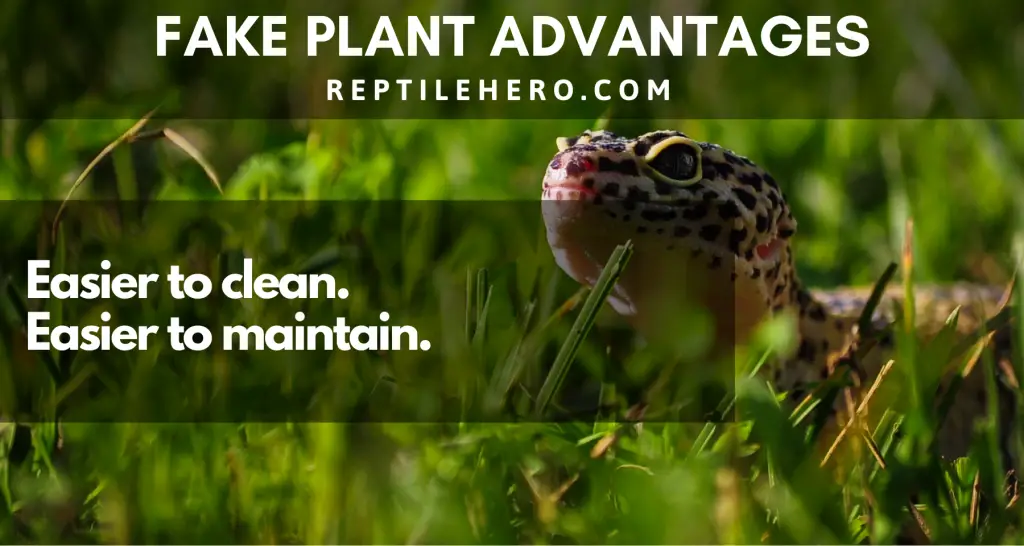
Conclusion
Aside from its aesthetics, a plant best for the gecko’s tank must be safe and functional. While it needs to be compact in size, it must also be tough and hardy with minimal water needs. Overall, one of the best plants I would choose for a leo’s enclosure is the Crassula ovata (here on Amazon).
Sources
[1] https://planthardiness.ars.usda.gov/PHZMWeb/Default.aspx
[2] https://www.reptilesmagazine.com/list-of-plants-that-can-be-toxic-to-reptiles/

